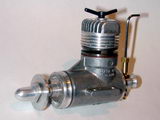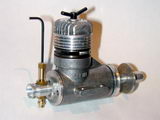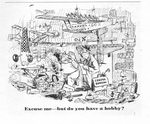| Name | Elfin 149 BB | Designer | Aerol Engineering |
| Type | Compression Ignition | Capacity | 1.49cc (0.091 cuin) |
| Bore | 0.503" | Stroke | 0.460" |
| Production run | unknown | Country of Origin | England |
| Photo by | Ron C | Year of manufacture | 1954 |
Background
The Elfin 149BB looks like it could be slammed into a brick wall at very high speed with no ill effect. Some might say it belongs on a brick wall, joining three pieces of galvanized water pipe together! The manufacturer, Aerol Engineering of Liverpool, England, had built up a fine reputation for contest performance with their plain bearing, front-rotary induction engines, the first of which had appeared in 1948. These featured "Arden" porting and "up-draft" induction at a time when the British market was largely dominated by side-port engines.
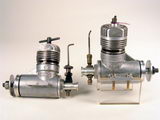 The first advertisement for the Twin Ball Race (TBR) series appeared in the Aeromodeller of October 1954. On offer were 1.49cc and 1.8cc versions. A 2.49cc TBR followed almost a year later. The 1.8cc seems a strange size, sitting rather between competition classes. Its presence is almost certainly due to the popularity of the earlier plain bearing 1.8cc Elfin updraft model with free-flighters due to its exceptional power to weight ratio--a feature the TBR replacement rather lacked [6]. Both engines shared the same crankcase casting and cylinder, the 1.8 simply having its stroke increased from 0.460" to 0.562" resulting in a somewhat taller engine (seen on the right in this photo from the Streigler collection).
The first advertisement for the Twin Ball Race (TBR) series appeared in the Aeromodeller of October 1954. On offer were 1.49cc and 1.8cc versions. A 2.49cc TBR followed almost a year later. The 1.8cc seems a strange size, sitting rather between competition classes. Its presence is almost certainly due to the popularity of the earlier plain bearing 1.8cc Elfin updraft model with free-flighters due to its exceptional power to weight ratio--a feature the TBR replacement rather lacked [6]. Both engines shared the same crankcase casting and cylinder, the 1.8 simply having its stroke increased from 0.460" to 0.562" resulting in a somewhat taller engine (seen on the right in this photo from the Streigler collection).
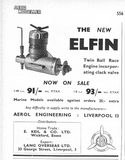 Internally, the cylinder design for the TBR series had changed to what we now call "Oliver porting", and the engine employed what the advertisement referred to as a "clack valve", the first English production engine to feature this type of induction [1]. This scheme (variously called flutter-valve, clack valve, clapper valve, and reed valve) had gained popularity in the USA through its success on the Thimble Drome Space Bug and Thermal Hopper. Production of the TBR range continued until 1958 when Aerol and Elfin engines disappeared from the market [2].
Internally, the cylinder design for the TBR series had changed to what we now call "Oliver porting", and the engine employed what the advertisement referred to as a "clack valve", the first English production engine to feature this type of induction [1]. This scheme (variously called flutter-valve, clack valve, clapper valve, and reed valve) had gained popularity in the USA through its success on the Thimble Drome Space Bug and Thermal Hopper. Production of the TBR range continued until 1958 when Aerol and Elfin engines disappeared from the market [2].
The engine was dubbed "heavy" by Ron Warring in his Aeromodeller review of January, 1952 [3] and seems to have been unable to shake this somewhat undeserved image. Clanford, in his A-Z reference reinforces this by calling them "over engineered", and "Nice lookers, but a bit heavy for serious contest work." [4] This is simply wrong (Clanford wrong? What a surprise  ). Warring can perhaps be excused for calling the 149 TBR heavy as there was little to really compare it against in 1954. Clanford should have and could have applied more rigour. Placing the 1.5cc BB engines in my own humble collection on the scales, we see that the Elfin TBR was really on the light end of the scale for this class:
). Warring can perhaps be excused for calling the 149 TBR heavy as there was little to really compare it against in 1954. Clanford should have and could have applied more rigour. Placing the 1.5cc BB engines in my own humble collection on the scales, we see that the Elfin TBR was really on the light end of the scale for this class:
| Elfin 149 PB | 76 gm |
| Elfin 149 TBR | 116 gm |
| Oliver Tiger Cub Mk II | 116 gm |
| Mk 17 | 130 gm |
| Sesqui | 134 gm |
But all reviews agreed that it was well designed, robust, powerful, and easy to operate. Like most reed valve engines, it exhibited a tendency to start backwards when fitted with a light prop--as it would be for team race work [3][5]. The remedy, as cited in both reviews, was to back off the compression screw before starting. This amount of fiddling during a pit-stop would be enough to cost the race and may explain why the engine did not feature prominantly in contest results.
Construction
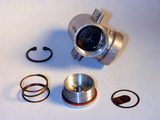 The "gas pipe fitting" appearance comes from the crankcase which looks like a plumber's T-piece due to the lack of any taper front to back and top to bottom. It is very short and places the engine mounting lugs in an unusual position. Longitudinally, they are forward of where common practice places them. However their location places them about equally disposed on the center of mass. Warring, in his Aeromodeller review [3] concluded that this was no bad thing as the engine vibrated quite noticeably. Second, they are centered vertically on the crankshaft axis. This would place the thrust line above the surface of the engine bearers if mounted upright. Most designers displace the lugs to align the thrust line with the mounting face of the lugs. I can see no reason for this choice, except perhaps aesthetics.
The "gas pipe fitting" appearance comes from the crankcase which looks like a plumber's T-piece due to the lack of any taper front to back and top to bottom. It is very short and places the engine mounting lugs in an unusual position. Longitudinally, they are forward of where common practice places them. However their location places them about equally disposed on the center of mass. Warring, in his Aeromodeller review [3] concluded that this was no bad thing as the engine vibrated quite noticeably. Second, they are centered vertically on the crankshaft axis. This would place the thrust line above the surface of the engine bearers if mounted upright. Most designers displace the lugs to align the thrust line with the mounting face of the lugs. I can see no reason for this choice, except perhaps aesthetics.
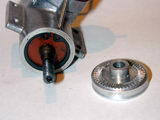 The vibration mentioned by Warring may have been due to the absence of any counterbalancing attempt. As seen above, the crankweb is perfectly circular and regular. Strangely, the anonymous review in Model Aircraft (probably Chinn) said the engine ran quite smoothly [5]. The shaft itself is a very tight fit in two ball races; themselves very tight fits in the die cast case. Even a meaningful blow from the brass mallet on the end of the shaft produced no movement, so further attempts at disassembly were abandoned. Sealing for crankcase compression on BB engines is a problem. "Sealed" races are sealed against dust and contaminants, not pressure. Many engine manufacturers resort to a short plain bearing between the ball races to provide the seal--rather defeating the purpose of friction reduction afforded by ball races. The Elfin BB uses a red fibre washer that is pressed against the front race by a circlip. The shaft is a close fit in the central hole. It's hard to say without further disassembly whether this is intended as a pressure seal or a dust cover.
The vibration mentioned by Warring may have been due to the absence of any counterbalancing attempt. As seen above, the crankweb is perfectly circular and regular. Strangely, the anonymous review in Model Aircraft (probably Chinn) said the engine ran quite smoothly [5]. The shaft itself is a very tight fit in two ball races; themselves very tight fits in the die cast case. Even a meaningful blow from the brass mallet on the end of the shaft produced no movement, so further attempts at disassembly were abandoned. Sealing for crankcase compression on BB engines is a problem. "Sealed" races are sealed against dust and contaminants, not pressure. Many engine manufacturers resort to a short plain bearing between the ball races to provide the seal--rather defeating the purpose of friction reduction afforded by ball races. The Elfin BB uses a red fibre washer that is pressed against the front race by a circlip. The shaft is a close fit in the central hole. It's hard to say without further disassembly whether this is intended as a pressure seal or a dust cover.
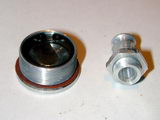 The reed is a rather intricate and delicate 0.002" thick punching. It is pressed into the backplate recess by a spring whose faces have been ground flat. Another circlip keeps everything in place. If you examine the photo above showing the disassembled valve carefully, you can see that the inner face of the recess has been very lightly rebated by 0.002" so that the reed only contacts against the outer clamping area and a thin, circular rim around the inlet hole (see the outstanding Carter air-brush cut-away in the Model Aircraft review). The aluminium screw-in venturi has a true venturi shape. That is, the 'exit' side has a more acute taper than the 'entry' side. The venturi is parallel at the point where the spray-bar passes through. It is locked by an aluminium nut and can be rotated to whatever angle is most practical for the installation.
The reed is a rather intricate and delicate 0.002" thick punching. It is pressed into the backplate recess by a spring whose faces have been ground flat. Another circlip keeps everything in place. If you examine the photo above showing the disassembled valve carefully, you can see that the inner face of the recess has been very lightly rebated by 0.002" so that the reed only contacts against the outer clamping area and a thin, circular rim around the inlet hole (see the outstanding Carter air-brush cut-away in the Model Aircraft review). The aluminium screw-in venturi has a true venturi shape. That is, the 'exit' side has a more acute taper than the 'entry' side. The venturi is parallel at the point where the spray-bar passes through. It is locked by an aluminium nut and can be rotated to whatever angle is most practical for the installation.
In the Aeromodeller review, Ron Warring says:
"...the natural frequency of this valve, as near as we could judge tuning it against a piano, is of the order of 26,000 cycles per minute so at half resonant frequency, 13,000 r.p.m., it should be opening and closing with maximum amplitude."
What marvellous pictures this conjures in the mind--preferably drawn by the wonderful Aeromodeller cartoonist--all the Aeromodeller staff clustered around the office upright with one playing the reed like a triangle, while the others humm along and plonk at random keys (for the trivia buffs, 26,000 cycles per minute is about 433Hz, which equates to a slightly flattened A above middle C). The AM test figures show a peak of .158 BHP at 13,600 rpm. If they are right about the resonant frequency of the reed, this is either an inspired piece of design, or a wondrously fortuitous coincidence!
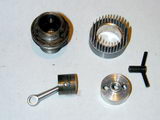 The hardened nickel steel cylinder screws into the case, seating on a substantial red fibre gasket. Three semicircular transfer channels are milled externally through the 40 TPI threads, leading to three large 5/32" diameter transfer ports drilled at an angle into the posts separating the three exhaust slits (ie, 'Oliver' type peripheral porting). For an engine designed to survive a junk-yard trash compactor, the cooling head fins are surprisingly delicate. They are retained by a cap which screws onto the upper part of the liner (40 TPI again), thus pressing the fins down against the liner's exhaust flange. This allows the head fins to be easily oriented for-aft as the cap is tightened. Very simple and practical. The compression screw threads into the cap, which is drilled for a pin spanner. As the engine was supplied without such a tool, Warring suggested using the tips of a pair of needle-nosed pliers for tightening. I suspect many surviving examples bear mute testimony to this butchery. The backplate too is tightened by a pin spanner, but requires a different pin spacing, so what is really required here is the famous Adjustable Texas Pin Spanner. Make one today...
The hardened nickel steel cylinder screws into the case, seating on a substantial red fibre gasket. Three semicircular transfer channels are milled externally through the 40 TPI threads, leading to three large 5/32" diameter transfer ports drilled at an angle into the posts separating the three exhaust slits (ie, 'Oliver' type peripheral porting). For an engine designed to survive a junk-yard trash compactor, the cooling head fins are surprisingly delicate. They are retained by a cap which screws onto the upper part of the liner (40 TPI again), thus pressing the fins down against the liner's exhaust flange. This allows the head fins to be easily oriented for-aft as the cap is tightened. Very simple and practical. The compression screw threads into the cap, which is drilled for a pin spanner. As the engine was supplied without such a tool, Warring suggested using the tips of a pair of needle-nosed pliers for tightening. I suspect many surviving examples bear mute testimony to this butchery. The backplate too is tightened by a pin spanner, but requires a different pin spacing, so what is really required here is the famous Adjustable Texas Pin Spanner. Make one today...
This piston is cast iron with a conical top to assist the loop scavenging. The contra piston is quoted in Aeromodeller as being steel and looks like it to me too. However the review states that it remained adjustable even after the engine heated up. Usually, steel in steel will lock solid shortly after the engine starts; a problem reported in one of the samples tested in the Model Aircraft review. The compression screw is very short, bringing one's pinkies uncomfortably close to the head while adjusting the compression. Perhaps to address this, the tips of the Tommy-bar are bent into a V. This is seldom a good idea as this process tends to loosen the press fit of the bar into the screw. Ron Warring notes that theirs came loose while running (their engine vibrated significantly), then fell out into the prop and was never seen again!
The prop driver is a locking taper fit onto the shaft where it tapers from the 1/4" journal to the 3/16" threaded section. The latter is quite short and Aeromodeller had difficulty fitting larger props because of this. On the sample in my collection, an attractive turned aluminium nut with a threaded shank is provided that effectively increases the grip length (and diameter) allowing thicker, high pitch props to be fitted. And I seriously doubt that the light groove turned in the edge of the driver was intended for a starting cord as Warring speculated. I'd call it purely a cosmetic affectation.
Conclusion
The Elfin 149 TBR (or BB, whatever) is an unusual looking engine that you are either going to love or hate. It has the distinction of being pioneering in several ways and its unusual construction aspects add to the appeal. I guess existing folk lore will continue to label it "heavy" even though this is not the case.
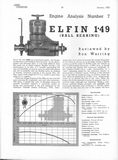 |
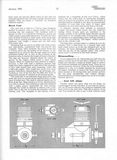 |
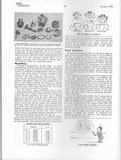 |
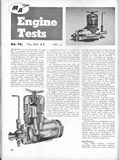 |
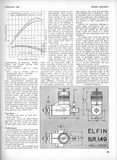 |
 |
References:
| [1] | Chinn, PGF: Accent on Power: First British Reed-Valve Engine, Model Aviation, Volume 13, Number 162, February 1955, p482. |
| [2] | Fisher, OFW: Collector's Guide to Model Aero Engines, Argus Books, Watford, 1977, p39. |
| [3] | Warring, RH: Engine Analysis No. 7: Elfin 1.49 (Ball Bearing), Aeromodeller, Volume XX, Number 228, January 1955, p36. |
| [4] | Clanford, M: A Pictorial A To Z of Vintage and Classic Model Airplane Engines, Clan Enterprises, Surrey 1987, p62. |
| [5] | anon: Engine Tests No. 70: ELFIN BR149, Model Aviation, Volume 14, Number 164, February 1955, p48. |
| [6] | anon: Engine Tests No. 77: The BR Elfin 1.8cc, Model Aviation, Volume 14, Number 171, February 1955, p344. |
Back to the Model Engine News Home Page
